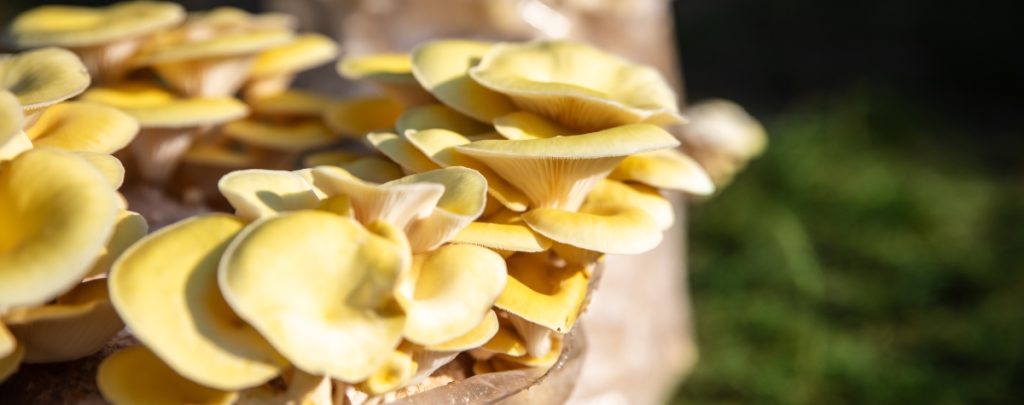If, like us, you’re a fan of oyster mushrooms, we recommend trying one of the more colorful varieties, yellow oyster mushrooms.
These vibrant, brightly-colored oysters are often hard to find in grocery stores as they don’t travel well.
But, because they’re easy to grow, striking, healthy and delicious, they’re popular with home cultivators, and yellow oyster mushroom grow kits and spawn are widely available.
Read on to learn what yellow oyster mushrooms are, where to find them, how to identify them, what they taste like and how to clean, store and cook them.
You’ll also discover the different ways you can grow yellow oysters at home with links to step-by-step growing instructions.
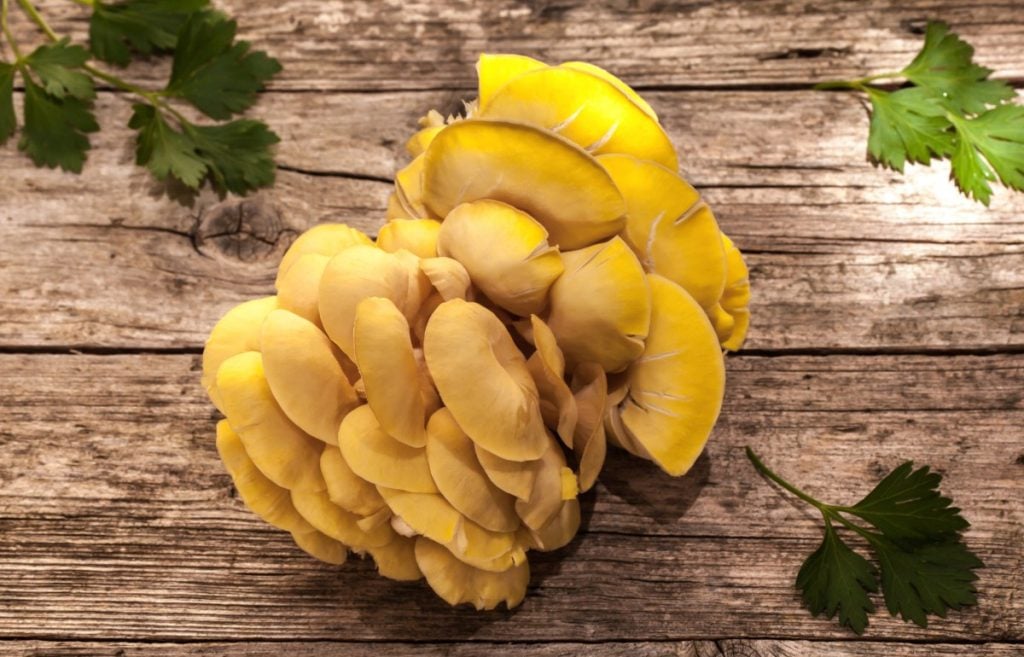
What Are Yellow Oyster Mushrooms?
Yellow oyster mushrooms (Pleurotus citrinopileatus), often also called golden oyster mushrooms, are edible gourmet mushrooms in the Pleurotaceae family.
They’re one of the smaller varieties of oyster mushrooms and also one of the most colorful.
Their thin, delicate caps range in color from bright daffodil yellow to golden yellow.
Like other oyster mushrooms, they grow in eye-catching clusters, making them a favorite at local farmer’s markets.
Yellow oyster are not suited to long-distance transportation as they have a short shelf life, and their fragile caps are easily damaged during harvesting, handling and transportation.
While you could forage for them in the wild, they’re some of the easiest mushrooms to grow at home and perfect for a small-scale mushroom growing business.
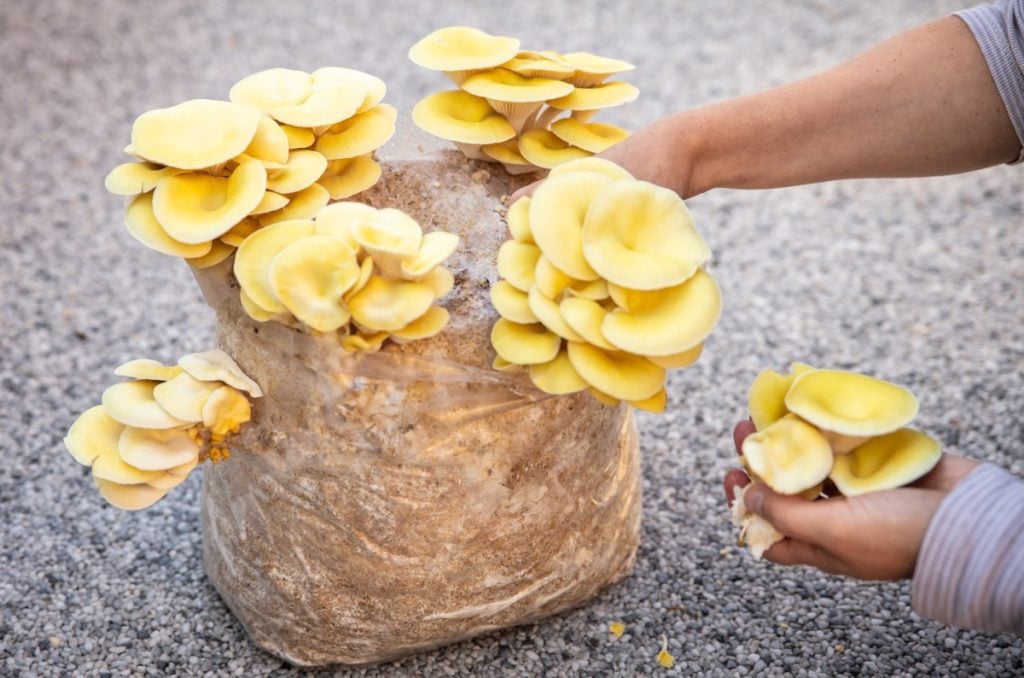
Are Golden Oysters Good to Eat?
Yes, golden oysters are good to eat, and although their fragile caps break easily when raw, they keep their shape when cooked and have a slightly chewy texture.
Yellow Oyster Mushroom Taste
Yellow oyster mushrooms have complex flavors that people describe differently, but all agree they’re delicious.
Some people describe the taste of yellow oysters as being sweet with a mild citrus, cinnamon-like flavor, but many others experience a subtle, nutty taste similar to cashews or almonds.
When yellow oysters are raw, some people think they smell like fresh watermelon, and the aroma of cooked yellow oysters reminds others of aged red wine.
Their texture varies, depending on how long they’re cooked, and can be crisp, meaty and chewy or smooth and velvety.
Which Oyster Mushroom is Tastiest?
Oyster mushrooms all have mild earthy flavors, other than a few like pink oysters that have hints of seafood.
Which is the tastiest is a matter of personal preference.
In our opinion, we would say either the pearl or yellow oyster mushrooms.
Pearl oyster caps are thicker and meatier than yellow oysters, with a slightly sweet, nutty flavor and earthy undertones.
Yellow oysters are thinner but more aromatic, and their flavors more complex and difficult to pin down.
No matter which oyster mushroom you choose, their subtle flavor, umami mushroom taste and meaty texture enhance any meal.

Should You Eat Yellow Oyster Mushrooms Raw or Cooked?
We recommend eating yellow oyster mushrooms cooked rather than raw. While raw yellow oysters are not harmful, they can be slightly bitter, and it’s not the best way to enjoy them.
Cooking brings out the yellow oysters flavors and enhances their nutritional value by releasing beneficial compounds.
Cooking also improves their spongy texture, and people describe the texture of cooked oyster mushrooms as velvety, meaty and even crispy.
If you want to add yellow oyster mushrooms to a salad, rather than using them raw, try sauteing them until they’re crispy.
Although they won’t keep their striking yellow color, their thin caps make a delicious substitute for bacon bits when crispy and are great in salads.
How to Cook Yellow Oyster Mushrooms
Yellow oyster mushrooms are exceptionally versatile, and their subtle fragrance and complex flavor go well with a wide range of dishes.
Everyone has their personal favorite way of using them, including:
- Sauteed with olive oil, butter and garlic until golden and slightly crispy
- Added to warm creamy soups and sauces
- Paired with pasta, risotto and noodle stir-fries
- In egg dishes like frittatas, omelets or quiches
- On pizza with mozzarella and sweet red peppers
- Sauteed until crispy and used in salads or as a garnish
- Made into mushroom steaks
Yellow oyster mushrooms are popular in Asian cuisine and pair well with ginger, soy sauce, garlic, tomatoes, chives, thyme, parsley, marjoram, seafood, pork and Asian vegetables.
If you’re looking for recipe ideas, we have 5 easy and delicious oyster mushroom recipes you can try, and below is a quick and easy yellow oyster mushroom recipe that will impress.
Yellow Oyster Mushroom Steaks
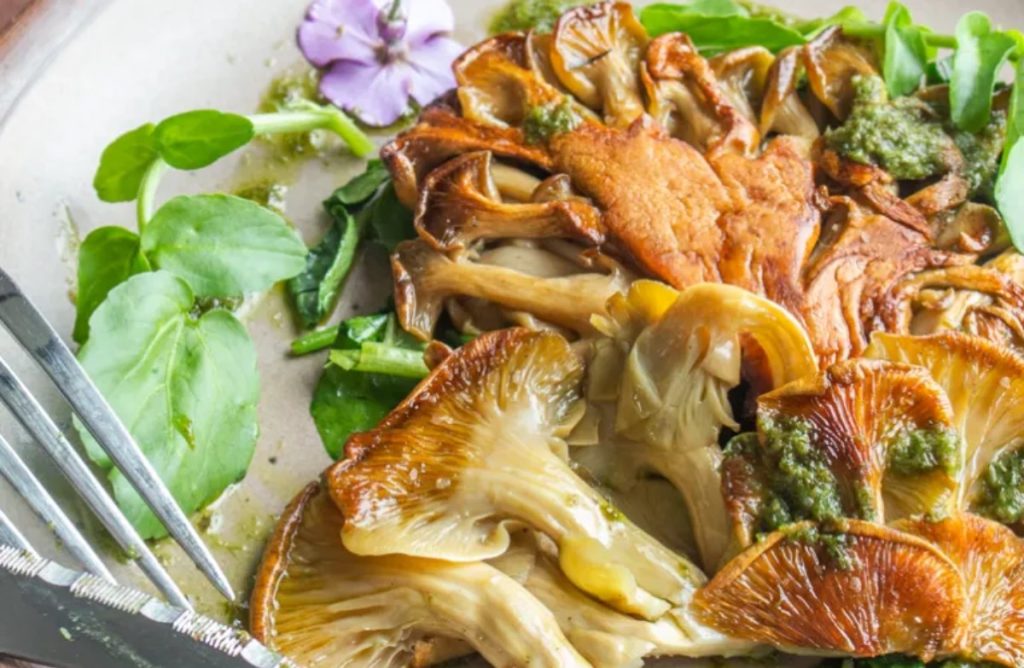
This recipe, adapted from forager chef, is the perfect way to serve wild mushrooms that grow in tight clusters.
Yellow oyster mushroom steaks are delicious, and you can serve them in several ways as a main course or side dish.
This recipe makes 2 servings, but if you have more guests, just add a cluster of mushrooms for each additional person.
Ingredients
- 2 clean, four to six-ounce (115 to 170 gram) clusters of yellow oyster mushrooms
- 2 tablespoons cooking oil
- Kosher salt and freshly ground black pepper
Instructions
- Heat the oil in a large pan on medium-high heat.
- Add the clusters of yellow oyster mushrooms and cook until lightly browned.
- Put a weight on top of the mushrooms and cook for a minute or two more until they’re golden. A bacon press or another pan will work as a weight.
- Flip the mushrooms, put the weight back on and cook for a couple more minutes.
- When done, remove the weight from the mushrooms, season lightly with salt and pepper and serve.
Serving Suggestions
- Serve them on their own with a lemon wedge and a salad or side of cooked greens.
- If you have a favorite creamy sauce, spread some on a plate and put the mushroom steak on top.
- Serve on a bed of greens and spoon over a vinaigrette dressing or some melted-infused butter.
Yellow Oyster Mushroom Health Benefits
Yellow oyster mushrooms are not only beautiful and delicious, they’re also nutrient-dense. And although not commonly thought of as medicinal mushrooms, they provide many health benefits.
A study that explored the composition of yellow oyster mushrooms showed that, like other mushrooms, yellow oysters are high in protein 22.10% and fiber 20.78% and low in fat 1.32%.
They’re also a good source of potassium, other minerals, vitamin B and essential amino acids.
Studies also show that compounds in yellow oyster mushrooms may help with managing weight loss and cholesterol levels and have antimicrobial and antioxidant activities.
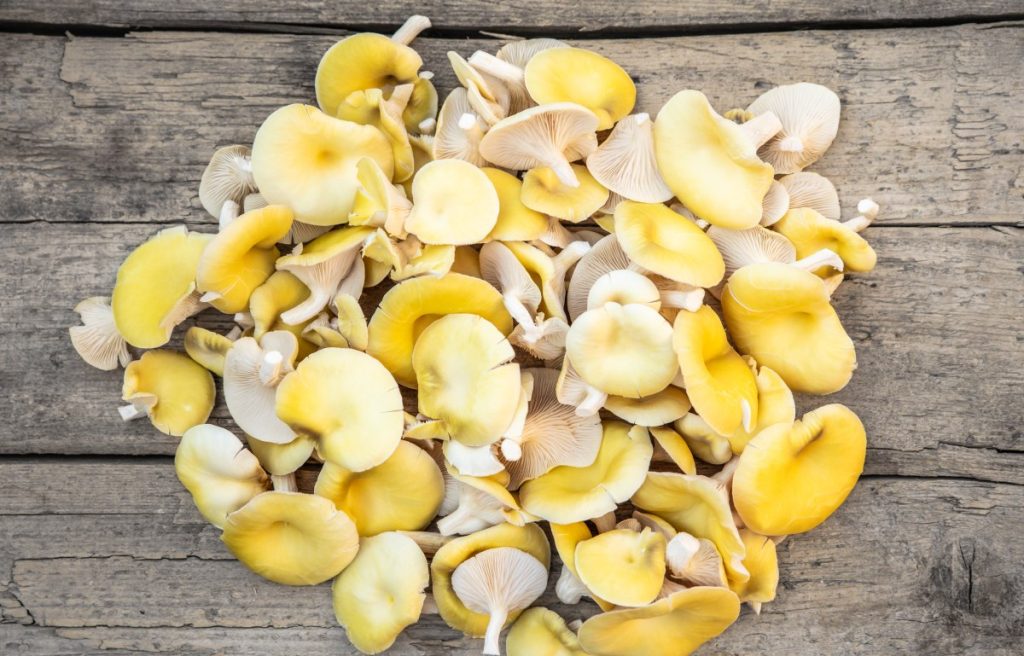
Where and When Do Yellow Oyster Mushrooms Grow?
Native to the hardwood forests of northern China, Japan and eastern Russia, yellow oyster mushrooms are now also found in the wild throughout Europe and North America.
As they’re widely cultivated by small-scale mushroom growers, it’s thought their spores spread into the wild from cultivated mushrooms.
Yellow oyster mushrooms are saprotrophic, meaning they feed on dead and dying hardwood trees.
You’ll find them growing on several hardwood trees like oak, beech, maple and cherry but elm trees are their preferred hosts.
Yellow oysters prefer warmer temperatures and fruit when temperatures are between 65 and 86F (18 and 30C) with humidity levels of 85% or more.
You’ll often find them in late summer and fall in the wild but sometimes come across them from spring to early winter, depending on the weather conditions.
Yellow oysters often fruit vigorously in dense clusters and can almost cover an entire tree stump.
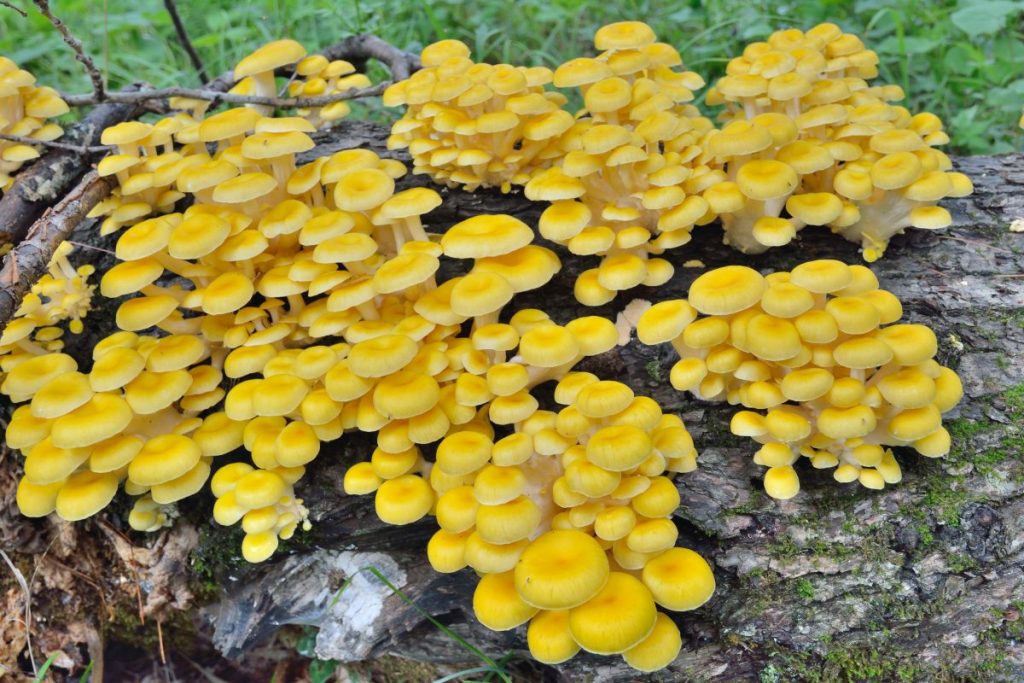
How to Identify Yellow Oyster Mushrooms?
Yellow oysters have several distinct characteristics, and their striking color makes it easier to identify them.
Here’s what to look for when identifying a yellow oyster mushroom:
- Smooth, bright yellow to golden brown caps, 0.75 to 2.5 inches (2 to 6 cm) in diameter with a velvety surface.
- Caps with a slight indent in the center that gets more pronounced as they mature to give them a funnel-like shape.
- Sometimes you’ll find mature caps faded to a very pale yellow and almost white.
- Widely spaced white or cream-colored gills that run down the stem.
- Curved white stems, usually around 0.75 to 2 inches (2 to 5 cm) in length that are joined together at the base.
- A white spore print.
- Tight clusters of mushrooms, especially when young.
- Multiple clusters that contain lots of individual mushrooms.
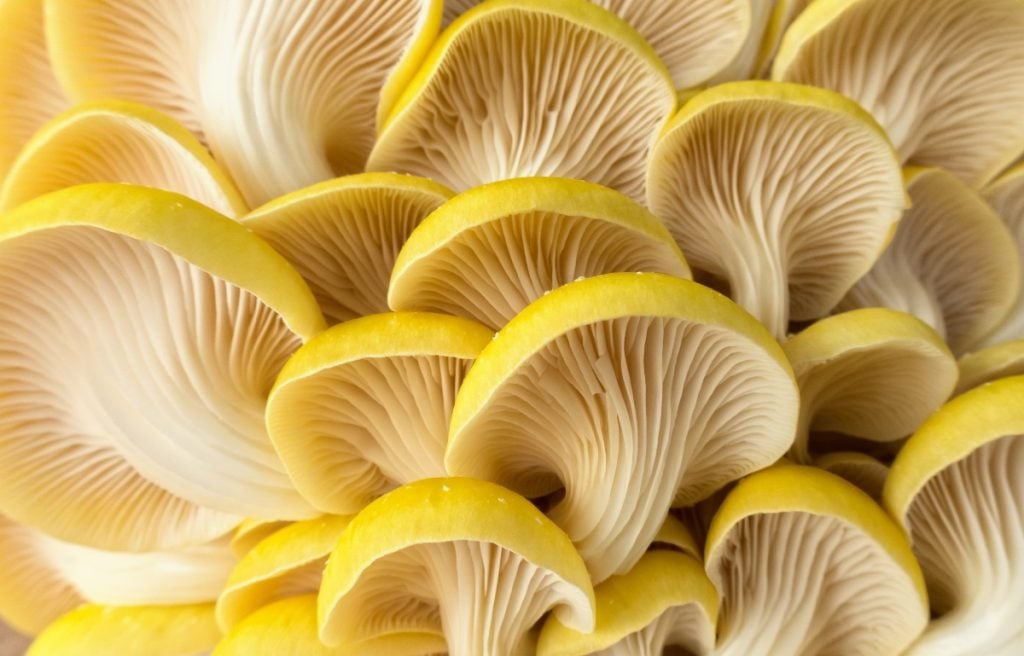
Yellow Oyster Mushroom Look-Alikes
Because of its color, the yellow oyster mushroom is easy to tell apart from other varieties of oyster mushrooms.
But, people sometimes confuse yellow oysters with honey mushrooms and jack-o-lantern mushrooms.
Like yellow oysters, these mushrooms grow in clusters on decaying hardwood stumps, logs and roots and have similarly shaped caps.
Fortunately, only one of them is poisonous, the jack-o-lantern.
How to Tell a Wild Yellow Oyster Mushroom From a Jack-o-lantern Mushroom
A mushroom identification app can help new foragers tell a wild yellow oyster from a jack-o-lantern.
But when dealing with poisonous look-alikes, it’s best to take an experienced forager with you to show you what to look for and confirm identification.
Although wild yellow oysters and jack-o-lanterns have some similarities, several characteristics help tell them apart, including:
- Color – Jack-o-lanterns range in color from yellowish orange to bright orange. Yellow oysters are a lighter shade and may be golden, bright daffodil or pale yellow but never orange.
- Gills – Yellow oysters have white to cream gills that run down the stem. While jack-o-lantern gills are orange to yellowish orange and attached to the stem at the top but not running all the way down.
- Cluster size – Yellow oysters tend to grow in large banding clusters and often have several dozen mushrooms in each. Jack-o-lanterns grow in smaller roundish clumps.
- Bioluminescence – The gills of a jack-o-lantern mushroom are bioluminescent and glow in the dark, emitting a blue-green light. Wild yellow oysters do not glow in the dark.
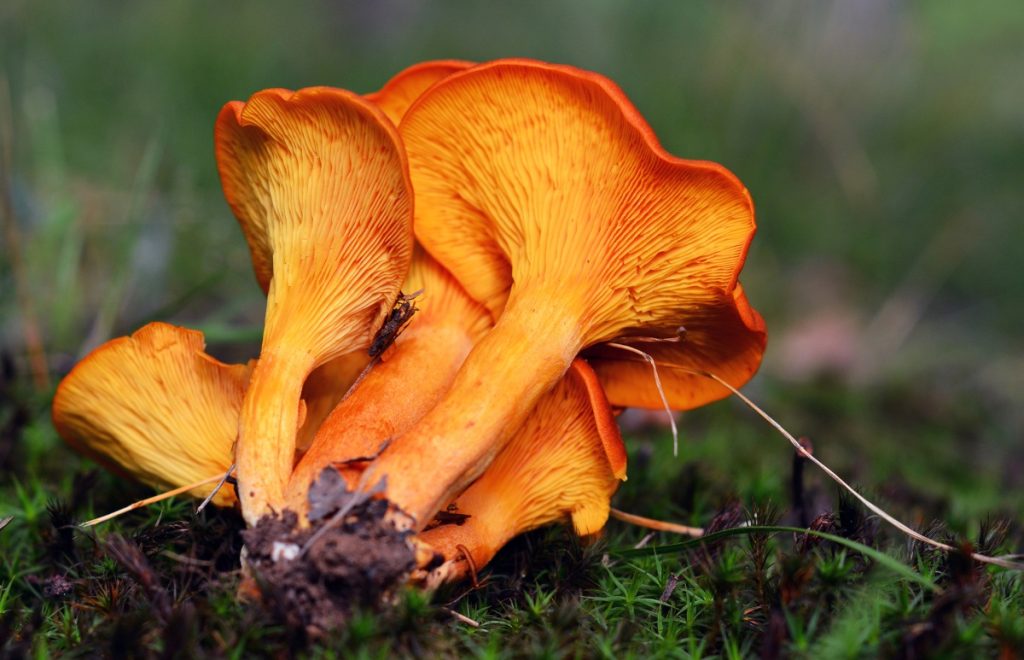
How to Grow Yellow Oyster Mushrooms
Yellow oysters are one of the easiest mushrooms to grow and great for beginner mushroom growers as they’ll grow at room temperature.
Like phoenix oysters, they enjoy warmer fruiting conditions between 64 to 86°F (18 to 30°C), so it’s best to grow them in summer in most regions.
There are several methods to choose from, and which is best will depend on your experience and how many mushrooms you want to grow.
One of the easiest ways to get started is with a mushroom growing kit, but you can also buy spawn and grow yellow oysters indoors in bags, jars or buckets, or outdoors on logs.
Mushroom Growing Kit
A mushroom grow kit is the easiest way for beginners to grow these colorful mushrooms and experience their unique flavor.
You can buy a yellow oyster mushroom growing kit online from a supplier near you. These usually contain a ready-to-grow, colonized substrate and detailed growing instructions.
You’ll need to cut an opening in the grow kit, place it in a spot with suitable fruiting conditions and mist it with water at least twice a day to maintain high humidity levels.
Like other oyster mushrooms, yellow oysters grow fast and within 5 to 10 days of opening your kit, you could have your first harvest of delicate yellow oyster mushrooms.
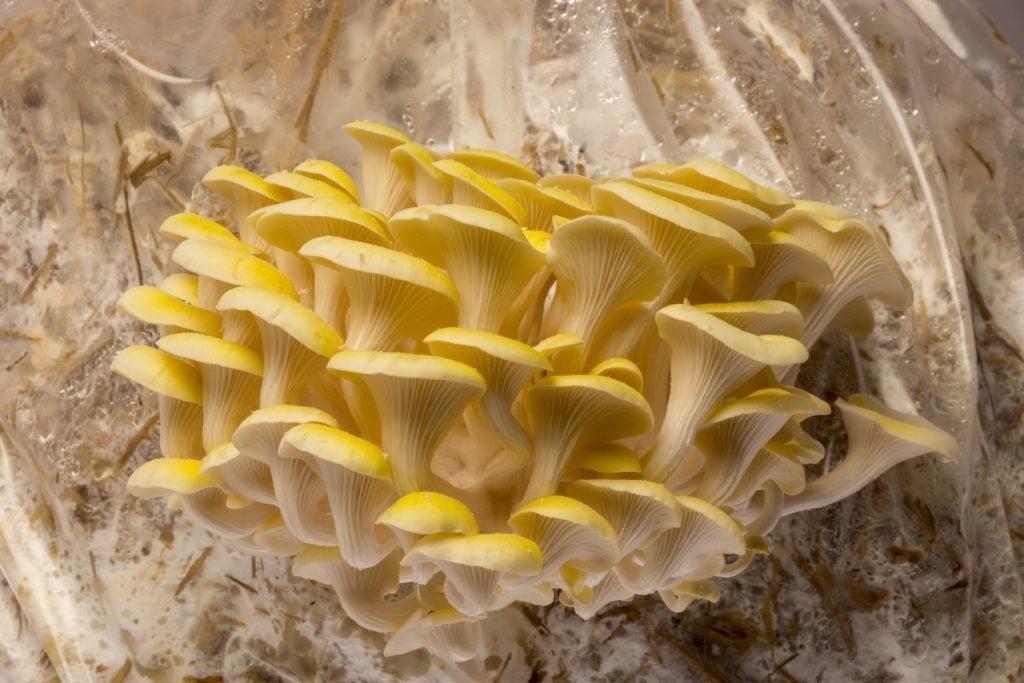
Indoors in Bags
If you’ve successfully grown oyster mushrooms from kits and want to experience the entire mushroom growing process, you can make your own fruiting blocks.
This involves ordering yellow oyster mushroom grain spawn from a supplier near you and preparing a substrate to provide the mycelium with the nutrients and moisture it needs to grow.
Yellow oyster mushrooms aren’t fussy and will grow on several substrates, including sugar cane bagasse, straw, hardwood sawdust, cardboard and coffee grounds.
We recommend using a substrate that’s easy to source in your area and mushroom grow bags. These come with filter patches that allow the mycelium to breathe during incubation.
The mushroom growing process has 4 main stages: preparation, inoculation, incubation and fruiting.
Our article, “How To Grow Oyster Mushrooms: The Ultimate Step By Step Guide,” will take you through the process step by step.
Outdoors on Logs
If you have space, growing oyster mushrooms outdoors on logs is relatively easy and provides an ongoing supply of yellow oyster mushrooms.
The process has the same stages as indoor growing, but you use different methods, and incubation takes much longer.
Although oyster mushrooms have a shorter incubation period than many other mushroom species, it still takes them a while to completely colonize a log.
Yellow oysters growing on logs usually fruit around 12 months after inoculation but can produce mushrooms in as little as 6 months.
Once established, the logs will fruit in spring, summer or early fall, depending on weather conditions, and often continue to produce mushrooms for several years.
To grow mushrooms outdoors, you’ll need to source suitable logs and order yellow oyster mushroom spawn plugs or sawdust spawn to inoculate the logs.
Our ultimate guide to growing mushrooms on logs will take you through the process step by step.
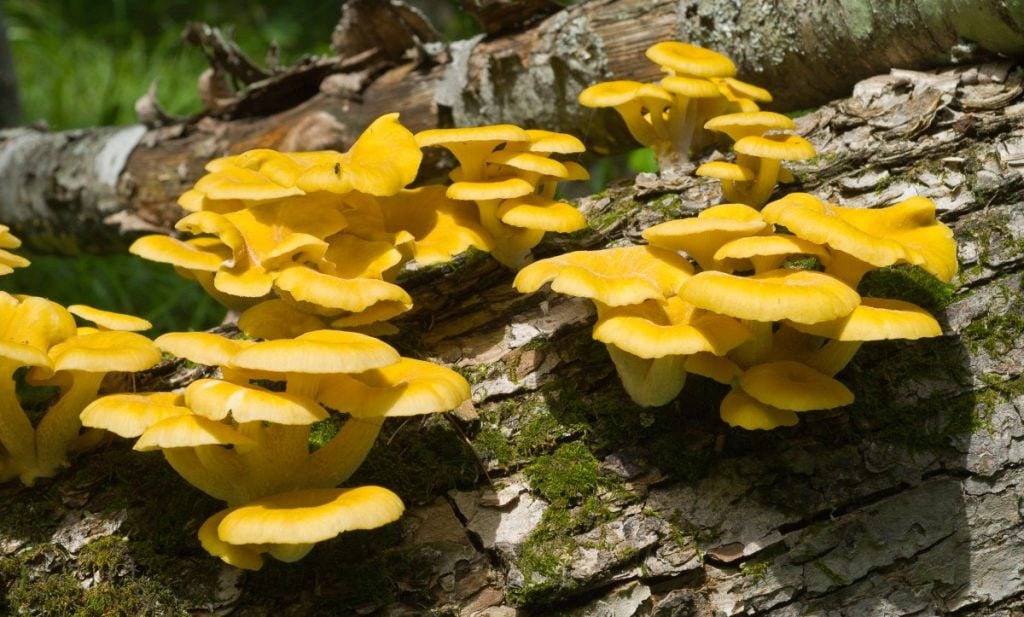
Harvesting Yellow Oyster Mushrooms
Like other oysters, yellow oysters are ready to harvest when they’re no longer doubling in size daily, and the edges of their caps are still curled under but beginning to flatten.
When the caps start to flatten and curl up, it indicates the mushrooms are ready to release their spores, and it’s best to harvest them before this.
Yellow oyster mushroom caps are thin and delicate, and you need to be careful when harvesting, handling and storing them as they break easily.
When harvesting yellow oyster mushrooms, remove the entire cluster at the base with a sharp knife.
In the video below, we show you what oyster mushroom caps look like when they’re ready for harvest.
How to Clean and Store Yellow Oyster Mushrooms
Yellow oyster mushrooms have beautiful caps that are thin and delicate, meaning they’re easily damaged.
Oyster mushrooms generally don’t have a long shelf life, and yellow oysters’ fragile caps make it harder to store them longer than a few days.
Try to eat fresh your yellow oysters as soon as possible after harvesting, but if you can’t, cleaning and storing them properly helps them last longer.
Cleaning Yellow Oyster Mushrooms
Cultivated yellow oysters don’t get very dirty, especially those grown indoors, and require minimal cleaning, if any.
Don’t clean your yellow oysters if you plan on storing them in the fridge, as this reduces their shelf life. Rather, store them as they are and clean them just before you cook them.
To clean yellow oysters, trim off the base of the stem and any bits with discoloration or insect damage, then wipe off any remaining dirt or debris with a damp cloth.
If there’s dirt lodged between the gills that you can’t reach without causing damage, give them a quick rinse under running water.
Then gently pat them dry with a paper towel or lay them out to dry on a clean kitchen towel.
Because yellow oyster mushrooms are so fragile, aim to handle them as little as possible.
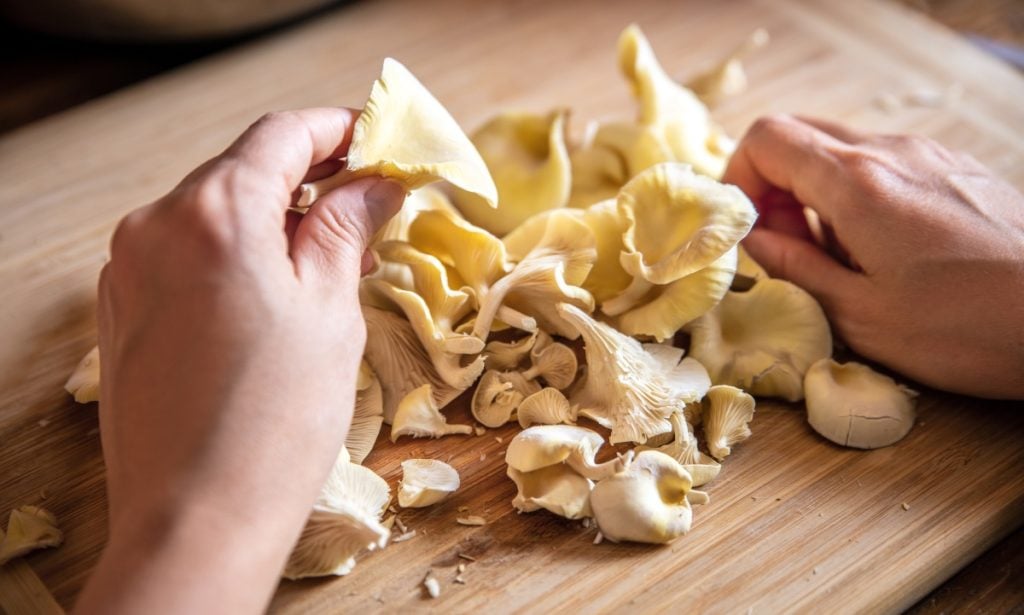
Storing Yellow Oyster Mushrooms
The best way to store yellow oyster mushrooms short-term is in the fridge in a paper bag or similar breathable container.
While this allows the mushrooms to breathe and prevents them from getting slimy, they will begin to dry out after a few days.
Yellow oyster mushroom caps are thin with a large surface area which means they dry out quite quickly when stored in the fridge.
Here are some things to keep in mind when storing yellow oysters in the fridge:
- Store them on a shelf in the fridge rather than in the crisper drawer.
- Be careful not to stack other items on top of your yellow oyster mushrooms, as they’ll get crushed.
- Don’t store your mushrooms next to strong-smelling items like garlic, onions, ginger, cheese or fish because they’ll absorb the odors and it will affect their taste.
If you come across loads of yellow oysters while foraging and can’t use them in a day or two, you can preserve them for later use.
Freezing and drying are the most common long-term preservation methods used to store oyster mushrooms, but there are several other ways you can preserve them.
Our article on preserving mushrooms has some ideas for you with step-by-step instructions.
Or take a look at the video below to discover 9 ways to preserve mushrooms.
Final Thoughts
As they’re fragile and don’t travel well, the best way to get your hands on fresh yellow oyster mushrooms is to grow them at home.
Their caps are smaller and thinner than other oyster mushrooms, and because of this, they usually don’t produce as high a yield as other varieties.
But, they’re beautiful and unusual and have complex aromatic flavors that are definitely worth trying.
Like other oyster mushrooms, yellow oysters are easy to grow and suitable for beginner mushroom growers.
To learn more about growing oyster mushrooms, visit our Mushroom Growing Hub or sign up for our introductory mushroom cultivation course.
In this course, we show you how to grow oyster mushrooms on a small scale using simple methods and minimal equipment.
